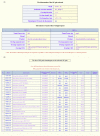BPhyOG: an interactive server for genome-wide inference of bacterial phylogenies based on overlapping genes
- PMID: 17650344
- PMCID: PMC1940028
- DOI: 10.1186/1471-2105-8-266
BPhyOG: an interactive server for genome-wide inference of bacterial phylogenies based on overlapping genes
Abstract
Background: Overlapping genes (OGs) in bacterial genomes are pairs of adjacent genes of which the coding sequences overlap partly or entirely. With the rapid accumulation of sequence data, many OGs in bacterial genomes have now been identified. Indeed, these might prove a consistent feature across all microbial genomes. Our previous work suggests that OGs can be considered as robust markers at the whole genome level for the construction of phylogenies. An online, interactive web server for inferring phylogenies is needed for biologists to analyze phylogenetic relationships among a set of bacterial genomes of interest.
Description: BPhyOG is an online interactive server for reconstructing the phylogenies of completely sequenced bacterial genomes on the basis of their shared overlapping genes. It provides two tree-reconstruction methods: Neighbor Joining (NJ) and Unweighted Pair-Group Method using Arithmetic averages (UPGMA). Users can apply the desired method to generate phylogenetic trees, which are based on an evolutionary distance matrix for the selected genomes. The distance between two genomes is defined by the normalized number of their shared OG pairs. BPhyOG also allows users to browse the OGs that were used to infer the phylogenetic relationships. It provides detailed annotation for each OG pair and the features of the component genes through hyperlinks. Users can also retrieve each of the homologous OG pairs that have been determined among 177 genomes. It is a useful tool for analyzing the tree of life and overlapping genes from a genomic standpoint.
Conclusion: BPhyOG is a useful interactive web server for genome-wide inference of any potential evolutionary relationship among the genomes selected by users. It currently includes 177 completely sequenced bacterial genomes containing 79,855 OG pairs, the annotation and homologous OG pairs of which are integrated comprehensively. The reliability of phylogenies complemented by annotations make BPhyOG a powerful web server for genomic and genetic studies. It is freely available at http://cmb.bnu.edu.cn/BPhyOG.
Figures


Similar articles
-
Reconstructing genome trees of prokaryotes using overlapping genes.BMC Bioinformatics. 2010 Feb 24;11:102. doi: 10.1186/1471-2105-11-102. BMC Bioinformatics. 2010. PMID: 20181237 Free PMC article.
-
A database of phylogenetically atypical genes in archaeal and bacterial genomes, identified using the DarkHorse algorithm.BMC Bioinformatics. 2008 Oct 7;9:419. doi: 10.1186/1471-2105-9-419. BMC Bioinformatics. 2008. PMID: 18840280 Free PMC article.
-
GeneTrees: a phylogenomics resource for prokaryotes.Nucleic Acids Res. 2007 Jan;35(Database issue):D328-31. doi: 10.1093/nar/gkl905. Epub 2006 Dec 6. Nucleic Acids Res. 2007. PMID: 17151073 Free PMC article.
-
Overlapping genes as rare genomic markers: the phylogeny of gamma-Proteobacteria as a case study.Trends Genet. 2006 Nov;22(11):593-6. doi: 10.1016/j.tig.2006.08.011. Epub 2006 Sep 12. Trends Genet. 2006. PMID: 16973237 Review.
-
Detecting lateral genetic transfer : a phylogenetic approach.Methods Mol Biol. 2008;452:457-69. doi: 10.1007/978-1-60327-159-2_21. Methods Mol Biol. 2008. PMID: 18566777 Review.
Cited by
-
ComPhy: prokaryotic composite distance phylogenies inferred from whole-genome gene sets.BMC Bioinformatics. 2009 Jan 30;10 Suppl 1(Suppl 1):S5. doi: 10.1186/1471-2105-10-S1-S5. BMC Bioinformatics. 2009. PMID: 19208152 Free PMC article.
-
Reconstructing genome trees of prokaryotes using overlapping genes.BMC Bioinformatics. 2010 Feb 24;11:102. doi: 10.1186/1471-2105-11-102. BMC Bioinformatics. 2010. PMID: 20181237 Free PMC article.
-
Utilization of multiple "omics" studies in microbial pathogeny for microbiology insights.Asian Pac J Trop Biomed. 2013 Apr;3(4):330-3. doi: 10.1016/S2221-1691(13)60073-8. Asian Pac J Trop Biomed. 2013. PMID: 23620861 Free PMC article. Review.
-
Bioinformatics in China: a personal perspective.PLoS Comput Biol. 2008 Apr 25;4(4):e1000020. doi: 10.1371/journal.pcbi.1000020. PLoS Comput Biol. 2008. PMID: 18437216 Free PMC article. Review. No abstract available.
-
Same-strand overlapping genes in bacteria: compositional determinants of phase bias.Biol Direct. 2008 Aug 21;3:36. doi: 10.1186/1745-6150-3-36. Biol Direct. 2008. PMID: 18717987 Free PMC article.
References
-
- Li WH. Fundamentals of Molecular Evolution. second. Sinauer Accociates, Sunderland, MA; 1999. p. 481.
Publication types
MeSH terms
LinkOut - more resources
Full Text Sources
Miscellaneous

